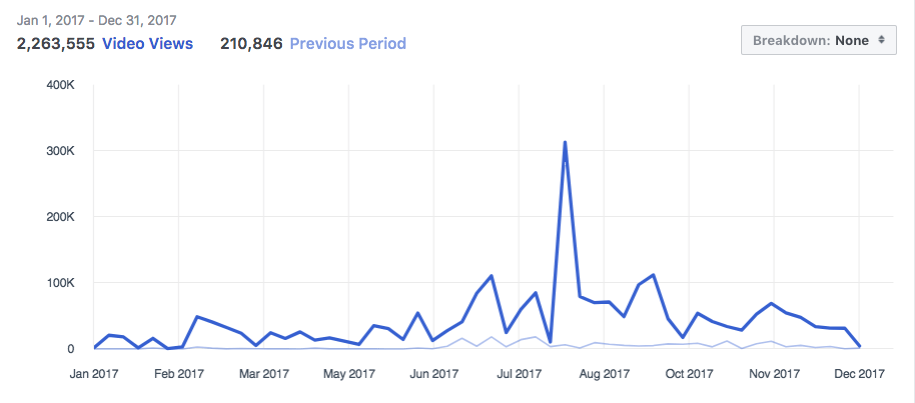Social media is changing at a rapid pace.
For example, the content format Stories was introduced on several major social media platforms slightly more than a year ago. Now, it’s one of the most popular content individuals are posting. More than 300 million people are sharing stories on Instagram and WhatsApp separately every day, and 70 million people were posting daily to Messenger Day just six months after its launch
10.
Due to its popularity, many businesses are now posting stories regularly, too.
To succeed on social media, it’s essential to stay ahead of the curve and understand the latest social media trends. Together with our State of Social 2018 report, we put together a comprehensive social media trends report. In this report, you’ll learn about the top major trends to help you succeed on social media in 2018.

Top 10 social media trends to know for 2018
This report is inspired by the annual Internet Trends report by Mary Meeker, a partner at Kleiner Perkins Caufield & Byers. Being one of the most anticipated reports every year, the Internet Trends report shares valuable insights and statistics about the technology industry. While our report is nowhere as comprehensive as the Internet Trends report, we hope to shed some light on the social media landscape.
Here’s a quick overview of the ten major social media trends happening right now:
- There are now almost 2.5 billion social media users
- Social media is going mobile
- Social messaging overtook social media
- Social messaging will greatly benefit businesses
- Chatbots are becoming the norm
- Businesses can no longer afford to ignore social customer service
- Organic reach and referral traffic are plummeting
- Video is still the most popular content type
- User-generated content can help drive reach and engagement
- Businesses are pouring more money into social ads
We will dive into these ten major social media trends below. If you prefer to read a slide deck, here’s the full slide deck:
This report wouldn’t have been possible without the amazing studies, research, and data available. We’re very grateful to the companies and organizations that have collected and analyzed the data. You can find out more about their findings by clicking on the tiny blue squares throughout the report, such as this
2.

1. There are now almost 2.5 billion social media users
Social media is one of the best ways to reach your target audience because of its sheer size and the amount of data available.
According to Statista, there are 2.46 billion social media users in 2017, and this number is ever growing. It is predicted that there will be more than three billion social media users in 2021 — just three years from now
3.
With social media, you can reach a massive amount of potential customers for free — through organic posts — or for a fee — through social media advertising. With ads targeting, you can reach very specific groups of audience based on their demographics, interests, past behavior, and more. There hasn’t been such a great opportunity to reach and engage your target audience before social media became popular. With this reason alone, I believe you can no longer ignore social media as part of running your business.
Here are the current user base of the six major social media platforms
4:
- Facebook: 2.07 billion monthly active users
- Instagram: 800 million monthly active users
- Twitter: 330 million monthly active users
- LinkedIn: 500 million members
- Pinterest: 200 million monthly active users
- Snapchat: 178 million daily active users
You can see the growth of the respective social media platforms in the following few slides:
2. Social media is going mobile
We are becoming glued to our smartphones.
Facebook studied the behavior of 100 people while they were watching TV at home. 94 of them had their smartphone in their hands while watching TV. And one of the top reasons they look away from the TV is to use their smartphone.
5More and more people are also using social media on their smartphone. In fact, the majority of social media users are using the apps via their smartphone:
- Facebook: 94 percent of its monthly active users
- Instagram: Because it’s a mobile-first app, I think it’s safe to assume most of its users use the app on mobile
- Twitter: 82 percent of its monthly active users
- LinkedIn: 60 percent of its unique visitors access LinkedIn via a mobile device
- Pinterest: 80 percent of its traffic comes from mobile devices
- Snapchat: Snapchat only has a mobile app and no web application yet.
On top of these statistics, comScore’s 2017 U.S. Mobile App Report found that 78 percent of social media time is spent on mobile devices.
This trend increases the importance of creating mobile-friendly or mobile-first content. A few things you could do include creating images with the recommended size that will be displayed fully on mobile or creating square or vertical videos, which will take up more real estate on the phone screen than landscape videos when viewed vertically.
Instagram has also made advances to bring TV-like experiences to mobile with the launch of their standalone IGTV app for long-form video.
3. Social messaging overtook social media
Since the rise of social media in the last decade, the rise of social messaging is the next transformational shift that’s happening.
In fact, social messaging has already surpassed social media usage. According to Business Insider, there are more people using the top four social messaging apps (WhatsApp, Messenger, WeChat, and Viber) than the top four social media apps (Facebook, Instagram, Twitter, and LinkedIn)
10. Facebook Messenger alone has more than 1.3 billion monthly active users
11, and Instagram is officially testing a standalone messaging app, Direct
12.
The growth in social messaging is not showing signs of slowing down. Despite having three years of double-digit growth, the number of mobile messaging users is still growing at a significant rate
13.
If social media has been a great opportunity for businesses, then social messaging cannot be ignored. And it is already showing tremendous benefits for businesses.
4. Social messaging will greatly benefit businesses
People used to communicate with businesses via the phone, then emails, and then social media. Now, it’s social messaging.
Facebook studied the messaging behavior of 12,500 people across 14 markets to understand consumers’ growing preference for messaging businesses. They found that messaging is helping businesses connect with their customers more than ever. Consumers use messaging to ask businesses questions, make appointments and purchases, and provide feedback.
Here are some other findings
14:
- Fifty-six percent would rather message than call a business for customer service
- Sixty-one percent likes receiving personalized messages from businesses
- More than fifty percent prefers shopping with a business they can message
Facebook is also increasingly helping businesses reach their customers via messaging apps. In 2017, they introduced Click-to-Messenger ads, Click-to-WhatsApp ads, and a new Facebook objective, Messages.
Consumers’ preferred way of communicating with businesses has always been shifting. Now, they are shifting towards social messaging. Is your business ready to receive your customers’ messages?
5. Chatbots are becoming the norm
The rising tide of social messaging also lifted the chatbot boat.
As Facebook Messenger grew, the number of bots in Messenger also grew — from 33,000 to more than 100,000 in just a year
15. There are also chatbots in WeChat, Slack, Viber, iMessage, and many other platforms.
A survey by Oracle found that 80 percent of senior marketing and sales executives around the world are already using chatbots for their business or plans to use them by 2020
16. It’s easy to understand why. Chatbots can be used for a wide variety of purposes such as marketing, payments, customer service, and more. They will allow businesses to automate and scale many manual processes and enjoy massive cost-savings. Juniper Research estimated that chatbots will help businesses save up to $8 billion every year by 2022
17.
According to Business Insider, chatbot adoption is also taking off on the consumer front. More than half of Americans between the age of 18 and 55 have used chatbots before
18. And consumers seem to be enjoying their interactions with chatbots, too. A survey of 5,000 people by LivePerson found that 38 percent felt positive about their chatbot experiences while only 11 percent felt negative
19.
If you want to start thinking about using chatbot for your business, Facebook Messenger might be a great place to stay. Here are some ideas on how your business can use Facebook Messenger bots.
6. Businesses can no longer afford to ignore social customer service
Customer service used to be private conversations between a customer and a customer service representative. Social media has changed that entirely.
The public nature of social media platforms is giving these conversations more exposure. A survey of more than 1,000 people by Sprout Social found that 46 percent of the respondents have “called out” or complained about a business on social media
20. Furthermore, with the ability to re-share a social media post, such complaints could be amplified and “go viral”.
Ignoring such social media posts can have dire repercussions for your business. Sprout Social discovered that, when shunned on social media, 30 percent of their respondents will go to a competitor and 26 percent will less likely use the company’s product or service. Such consequences help keep businesses accountable, and that’s why social media is now the top channel for customer service
21.
On the other hand, responding to these social media posts can have several positive effects for businesses
22:
- 70 percent are more likely to use your product or service
- 75 percent are likely to share the good experience on their own social media profile
- 73 percent will share the positive interaction with their friends
At Buffer, we use Buffer Reply to listen to, engage, and help our customers on various social media platforms such as Twitter, Facebook, Messenger, and Instagram.
7. Organic reach and referral traffic are plummeting
In 2014, the organic reach on Facebook has fallen to six percent from 12 percent just the year before
23. The organic reach on Facebook is likely even low now as Facebook introduced changes to its algorithm to prioritize posts from family and friends rather than Pages. Both Instagram and Twitter also have an algorithmic timeline, which affects organic reach. When we first wrote about this last year, many of our readers mentioned that they have also been experiencing such a fall.
Referral traffic from social media has also been falling as a result of lower organic reach. When fewer people see your social media posts, even fewer will click on your links and visit your website. According to Parse.ly, which monitors the referral traffic to more than 2,500 online media sites, referral traffic from Facebook — the top social referral source for many sites — has been almost halved in the past year
24.

This is in line with why we think organic social media is for engagement and brand building, not referral traffic or revenue. Social media is becoming an engagement channel.
While studies have shown that the average engagement on Facebook has fallen
25, we were lucky to be able to increase our Facebook engagement by 50 percent year-on-year with some of these tactics.
8. Video is still the most popular content type
For the last two years, we (and many others) have been saying that video is the most popular content type. 2018 will be no different.
Buzzsumo’s research on 880 million Facebook posts in 2017 found that video posts have the highest average engagement and twice the level of engagement of other post types on average
26. We have seen great results with our Facebook videos, too. Our Facebook video views increased by more than 900 percent year-on-year to 2.3 million in 2017 (with the help of a little Facebook promotion).

There are also many pieces of anecdotal evidence of the increasing popularity and importance of video. For example, Facebook and Instagram have been introducing many new video features over the recent years such as live videos and Stories. LinkedIn has also recently introduced native LinkedIn videos.
Marketers are also planning to spend more on video advertising in 2018. According to a survey by Animoto, more than 50 percent of marketers surveyed had planned to increase their spend on video ads on Facebook (63 percent), YouTube (60 percent), Twitter (52 percent), and Instagram (50 percent)
27.
2018 will again be the year of video for social media. Here are some social video marketing tips for you.
9. User-generated content can help drive reach and engagement
With organic reach on social media falling, businesses are looking around for alternative ways to reach their audiences. One of which is user-generated content.
Many major brands such as BMW, Netflix, and Starbucks are reposting user-generated content as part of their content strategy, especially on Instagram
28.
If you were to take a look at some statistics about user-generated content, it’ll be easy to understand why.
- User-generated content featuring a brand drove seven times higher engagement than brand-generated Facebook posts
- Forty-five percent of the respondents of 4,500-people survey look at user-generated images for inspiration at least once a day
- Respondents of the same survey trust images from other consumers seven times more than ads
- Fifty-six percent of the respondents are more likely to buy a product after seeing a positive customer-generated post of it
Instead of producing their own content all the time, businesses are tapping into the power of their audience (and influencers) and reposting user-generated content, which generates more engagement and trust. By reposting their customers’ social media posts, they are also encouraging more customers to post about their brands on social media, thereby increasing their brand reach.
If you are interested in getting started with such a content strategy in 2018, here’s our guide to running a user-generated content campaign.
10. Businesses are pouring more money into social ads
To combat falling organic reach and boost their social media marketing, businesses are also turning to social media advertising.
There are over six million Facebook advertisers and two million Instagram advertisers
33. Instagram added the second million advertisers in just six months.
Social media ad spending has also been on the rise, growing more than 20 percent annually. eMarketer estimates that this high growth rate would continue until at least 2018 while Advertising agency Zenith Optimedia predicts that social media ad spending will overtake newspaper ad spending by 2020
34.
The high growth in the number of social media advertisers and social media ad spending is a great indication of the effectiveness (or necessity) of social media ads for businesses.
If you are just considering social media advertising and not sure which social media platform to start with, Facebook is the platform that produces the best ROI according to social media marketers around the world
35. Here’s our Facebook advertising guide to help you get started.

What other social media trends have you spotted?
As the major social media platforms continue to grow and introduce new features, the social media landscape will only get more exciting. We hope by sharing these ten current social media trends, you can stay ahead of the curve and succeed on social media.
- There are now almost 2.5 billion social media users
- Social media is going mobile
- Social messaging overtook social media
- Social messaging will greatly benefit businesses
- Chatbots are becoming the norm
- Businesses can no longer afford to ignore social customer service
- Organic reach and referral traffic are plummeting
- Video is still the most popular content type
- User-generated content can help drive reach and engagement
- Businesses are pouring more money into social ads
Have you spotted any other social media trends that I’ve missed? It’ll be great to know about them!
—
The awesome featured image was taken from Unsplash.
Try Buffer for free
190,000+ creators, small businesses, and marketers use Buffer to grow their audiences every month.




